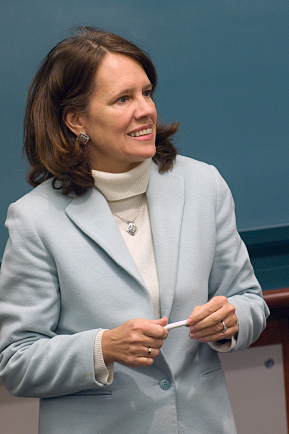Student Philanthropists Get Real Cash
SMG course puts $15,000 toward charitable causes

Maureen Merrigan and her classmates in the School of Management course Nonprofit Management have a problem. They need to give away thousands of dollars. And it’s a whole different story, Merrigan says, when the money is real and so are the needs.
“It’s going to be tough finding a nonprofit to fund that we can all agree on,” says Merrigan (CAS’08). “We’ve discussed splitting into groups or saving some of the money for next year.”
The money that Merrigan is talking about is a $15,000 fund that Fidelity Investments has donated to the University as part of a nationwide pilot program to nurture young philanthropists on college campuses. This spring, some 25 undergraduates taking the SMG course will act as a genuine charitable organization and disburse the money to a worthy cause. To do it right, the students will form a board of directors, create donor guidelines, and research the inner workings of potential nonprofit candidates.
“The idea is that students learn a lot more from doing than reading about it,” says Kristen McCormack, faculty director of SMG’s Public and Nonprofit Management Program.
The philanthropic initiative, called Students4Giving, is a joint effort of Campus Compact, a national coalition of college and university presidents dedicated to civic and community engagement on campus, and the Fidelity Charitable Gift Fund, the charitable arm of Fidelity Investments and the country’s fourth-largest public charity. After BU joined Campus Compact this year, McCormack, with the help of several students, submitted a Students4Giving proposal. Of the 35 institutions applying for the seed funds, 5 were chosen: BU, the University of North Carolina at Chapel Hill, Portland Community College, in Portland, Ore., California State University, in Fresno, Calif., and Whitworth University, in Spokane, Wash.
“Students are going to learn all about the challenges involved in giving away money,” McCormack says. “They’re also going to learn the characteristics of a well-managed nonprofit organization, and they’re going to figure out what it means to have impact in the community — is it the number of people you serve, the quality of services, or whether you’re making change in a broader context?”
Merrigan, an archaeology major, helps run the BU Community Service Center’s Student Food Rescue, a campus volunteer group that collects and distributes food to shelters, meal programs, and food pantries. After graduation, she’d like to develop youth programs in museums. “I’m very familiar with managing volunteers,” she says, “but the business side of a charity is so foreign.”
Jon Hammer (SMG’08), a business administration major taking the class, says that this is the type of grant he would expect to see in an MBA program.
“It’s a pretty unique opportunity for students at our level to have a real financial impact on real nonprofit organizations,” he says. “It gives us a chance to dig deep into the activities of several organizations to see where we can make the biggest difference and how it should be done.”
That’s precisely what Fidelity has in mind, says Sarah Libbey, senior vice president of marketing for the Fidelity Charitable Gift Fund, which has disbursed $7.3 million since 1991.
“Our goal is to inspire students to be thoughtful philanthropists while giving them the skills to assess the needs of the local nonprofits,” she says. “We hope this will be the beginning of a lifetime of community involvement.”
Merrigan sees things the same way.
“It’s important to instill social responsibility no matter the age,” she says. “Many of us here at BU come from privileged backgrounds. We’re all privileged to attend BU. It’s important to give back.”
Caleb Daniloff can be reached at cdanilof@bu.edu.
Comments & Discussion
Boston University moderates comments to facilitate an informed, substantive, civil conversation. Abusive, profane, self-promotional, misleading, incoherent or off-topic comments will be rejected. Moderators are staffed during regular business hours (EST) and can only accept comments written in English. Statistics or facts must include a citation or a link to the citation.